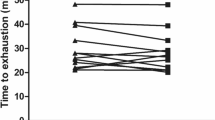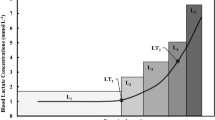Abstract
Light and moderate exercise elevates the regional cerebral blood flow by ~20% as determined by ultrasound Doppler sonography (middle cerebral artery mean flow velocity; MCA V mean). However, strenuous exercise, especially in the heat, appears to reduce MCA V mean more than can be accounted for by the reduction in the arterial CO2 tension (P aCO2). This study evaluated whether the apparently large reduction in MCA V mean at the end of exhaustive exercise relates to an enhanced cerebrovascular CO2 reactivity. The CO2 reactivity was evaluated in six young healthy male subjects by the administration of CO2 as well as by voluntary hypo- and hyperventilation at rest and during exercise with and without hyperthermia. At rest, P aCO2 was 5.1±0.2 kPa (mean ± SEM) and MCA V mean 50.7±3.8 cm s−1 and the relationship between MCA V mean and P aCO2 was linear (double-log slope 1.1±0.1). However, the relationship became curvilinear during exercise (slope 1.8±0.1; P<0.01 vs. rest) and during exercise with hyperthermia (slope 2.3±0.3; P<0.05 vs. control exercise). Accordingly, the cerebral CO2 reactivity increased from 30.5±2.7% kPa−1 at rest to 61.4±10.1% kPa−1 during exercise with hyperthermia (P<0.05). At exhaustion P aCO2 decreased 1.1±0.2 kPa during exercise with hyperthermia, which, with the determined cerebral CO2 reactivity, accounted for the 28±10% decrease in MCA V mean. The results suggest that during exercise changes in cerebral blood flow are dominated by the arterial carbon dioxide tension.


Similar content being viewed by others
References
Ainslie PN, Ashmead JC, Ide K, Morgan BJ, Poulin MJ (2005) Differential responses to CO2 and sympathetic stimulation in the cerebral and femoral circulations in humans. J Physiol 566:613–624
Bradac GB, Simon RS, Heidsieck CH (1976) Angiographically verified transient alteration of intercranial arteries and veins in dependence of different CO2 tension. Neuroradiology 10:257–262
Edwards MR, Lin DC, Hughson RL (2001) Modeling the interaction between perfusion pressure and CO2 on cerebral blood flow. Adv Exp Med Biol 499:285–290
Edwards MR, Topor ZL, Hughson RL (2003) A new two-breath technique for extracting the cerebrovascular response to arterial carbon dioxide. Am J Physiol 284:R853–R859
Giller CA, Levine BD, Meyer Y, Buckey JC, Lane LD, Borchers DJ (1992) The cerebral hemodynamics of normotensive hypovolemia during lower-body negative pressure. J Neurosurg 76:961–966
Henry RA, Lu IL, Beightol LA, Eckberg DL (1998) Interactions between CO2 chemoreflexes and arterial baroreflexes. Am J Physiol 274:H2177–H2187
Ide K, Pott F, Van Lieshout JJ, Secher NH (1998) Middle cerebral artery blood velocity depends on cardiac output during exercise with a large muscle mass. Acta Physiol Scand 162:13–20
Ide K, Gulløv AL, Pott F, van Lieshout JJ, Koefoed BG, Petersen P, Secher NH (1999) Middle cerebral artery blood velocity during exercise in patients with atrial fibrilation. Clin Physiol 19:284–289
Ide K, Boushel R, Sorensen HM, Fernandes A, Cai Y, Pott F, Secher NH (2000) Middle cerebral artery blood velocity during exercise with beta-1 adrenergic and unilateral stellate ganglion blockade in humans. Acta Physiol Scand 170:33–38
Ide K, Eliasziw M, Poulin MJ (2003) The relationship between middle cerebral artery blood velocity and end-tidal PCO2 in the hypocapnic–hypercapnic range in humans. J Appl Physiol 95:129–137
Johnsson P, Messeter K, Ryding E, Kugelberg J, Stahl E (1989) Cerebral vasoreactivity to carbon dioxide during cardiopulmonary perfusion at normothermia and hypothermia. Ann Thorac Surg 48:769–775
Jones NL, Robertson DG, Kane JW (1979) Difference between end-tidal and arterial PCO2 in exercise. J Appl Physiol 47:954–960
Jordan J, Shannon JR, Diedrich A, Black B, Costa F, Robertson D, Biaggioni I (2000) Interaction of carbon dioxide and sympathetic nervous system activity in the regulation of cerebral perfusion in humans. Hypertension 36:383–388
Jørgensen LG (1995) Transcranial Doppler ultrasound for cerebral perfusion. Acta Physiol Scand Suppl 625:1–44
Kety SS, Schmidt CF (1948) The effects of altered arterial tensions of carbon dioxide and oxygen on cerebral blood flow and cerebral oxygen consumption of normal young men. J Clin Invest 27:484–492
LeMarbre G, Stauber S, Khayat RN, Puleo DS, Skatrud JB, Morgan BJ (2003) Baroreflex-induced sympathetic activation does not alter cerebrovascular CO2 responsiveness in humans. J Physiol 551:609–616
Levine BD, Giller CA, Lane LD, Buckey JC, Blomqvist CG (1994) Cerebral versus systemic hemodynamics during graded orthostatic stress in humans. Circulation 90:298–306
Linkis P, Jørgensen L, Olesen HL, Madsen PL, Lassen NA, Secher NH (1995) Dynamic exercise enhances regional cerebral artery mean flow velocity. J Appl Physiol 78:12–16
Mayberg TS, Lam AM, Matta BF, Visco E (1996) The variability of cerebrovascular reactivity with posture and time. J Neurosurg Anesthesiol 8:268–272
Meadows GE, Dunroy HM, Morrell MJ, Corfield DR (2003) Hypercapnic cerebral vascular reactivity is decreased, in humans, during sleep compared with wakefulness. J Appl Physiol 94:2197–2202
Nielsen B, Strange S, Christensen NJ, Warberg J, Saltin B (1997) Acute and adaptive responses in human to exercise in a warm, humid environment. Pflugers Arch 434:49–56
Nybo L, Nielsen B (2001) Middle cerebral artery blood velocity is reduced with hyperthermia during prolonged exercise in humans. J Physiol 534:279–286
Nybo L, Moller K, Volianitis S, Nielsen B, Secher NH (2002a) Effects of hyperthermia on cerebral blood flow and metabolism during prolonged exercise in humans. J Appl Physiol 93:58–64
Nybo L, Secher NH, Nielsen B (2002b) Inadequate heat release from the human brain during prolonged exercise with hyperthermia. J Physiol 545:697–704
Pott F, Jensen K, Hansen H, Christensen NJ, Lassen NA, Secher NH (1996) Middle cerebral artery blood velocity and plasma catecholamines during exercise. Acta Physiol Scand 158:349–356
Reivich M (1964) Arterial PCO2 and cerebral hemodynamics. Am J Physiol 206:25–35
Rowell LB, Marx HJ, Bruce RA, Conn RD, Kusumi F (1966) Reductions in cardiac output, central blood volume and stroke volume with thermal stress in normal men during exercise. J Clin Invest 45:1801–1816
Schibye B, Klausen K, Trap-Jensen J, Lund JO, Hartling O (1988) Effects of acute hypoxia and CO2 inhalation on systemic and peripheral oxygen uptake and circulatory responses during moderate exercise. Eur J Appl Physiol 57:519–525
Serrador JM, Picot PA, Rutt BK, Shoemaker JK, Bondar RL (2000) MRI measures of middle cerebral artery diameter in conscious humans during simulated orthostasis. Stroke 31:1672–1678
Suehiro E, Ueda Y, Wei EP, Kontos HA, Povlishock JT (2003) Posttraumatic hypothermia followed by slow rewarming protects the cerebral microcirculation. J Neurotrauma 20:381–390
van Lieshout JJ, Pott F, Madsen PL, van Goudoever J, Secher NH (2001) Muscle tensing during standing: effects on cerebral tissue oxygenation and cerebral artery blood velocity. Stroke 32:1546–1551
Author information
Authors and Affiliations
Corresponding author
Rights and permissions
About this article
Cite this article
Rasmussen, P., Stie, H., Nielsen, B. et al. Enhanced cerebral CO2 reactivity during strenuous exercise in man. Eur J Appl Physiol 96, 299–304 (2006). https://doi.org/10.1007/s00421-005-0079-3
Accepted:
Published:
Issue Date:
DOI: https://doi.org/10.1007/s00421-005-0079-3




